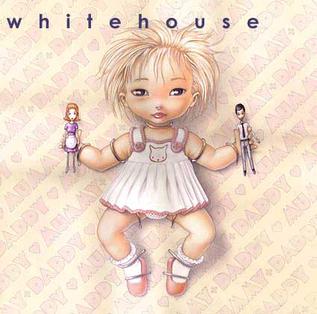
Whitehouse were an English noise music band formed in 1980. The group is largely credited for the founding of the power electronics genre. Whitehouse was founded and ended as a duo consisting of electronics player Philip Best and vocalist William Bennett, however the group is perhaps best–recognized for their 20-year-tenure as a three-piece with synthist Peter Sotos as a member, who joined the band in 1983 and left in 2003.

Final is a project of English musician Justin Broadrick, creator of the band Godflesh, which he started when he was 13 years old. Unlike Godflesh, Final is primarily electronic in nature, taking on a space-like, dark ambient sound.

Inside Information is the sixth studio album by the British-American rock band Foreigner, released on December 7, 1987. The album debuted at 15, on the Billboard 200 Albums Chart and was certified Platinum in the U.S. for sales exceeding one million copies. Although a huge standard by any country's charting method, the band's sales were certainly plummeting since the release of 4 in 1981. It was the last album to feature the '80s core lineup of Gramm, Jones, Wills, and Elliott.

Pass Out of Existence is the debut studio album by American heavy metal band Chimaira, released on October 2, 2001. According to vocalist Mark Hunter, as of 2003, the band has sold 44,000 copies of the album in the United States alone. Pass Out of Existence features an altogether different sound when compared to the band's later albums, leaning more towards nu metal rather than the groove metal style featured in later material. Its heavy use of electronics has also been noted.

Psychopathia Sexualis is the seventh album by Whitehouse released in 1982 on the Come Organisation label. It was on the liner notes for the album that principal member William Bennett first used the term "Power electronics" to describe the group's music.

The Call of the Wretched Sea is the debut album by the German funeral doom band Ahab. It was released in October 2006.
Power electronics is a style of noise music that typically consists of static, screeching waves of feedback, analogue synthesizers making sub-bass pulses or high frequency squealing sounds, with sometimes screamed and distorted vocals. The genre is noted for its influence from industrial.

The Hits is a compilation album from REO Speedwagon. It contains hits such as "Can't Fight This Feeling" and "Keep on Loving You", as well as new tracks "Here with Me" and "I Don't Want to Lose You". "Here with Me" cracked the top 20 on the Billboard Hot 100. and the top ten on the Adult Contemporary chart; however, it would be the last single to feature drummer Alan Gratzer and guitarist Gary Richrath, as they each left the band within the year following this album's release. The album has sold over 4 million copies in the U.S. which led it to go 4× Platinum.

Birthdeath Experience is the debut studio album by power electronics band Whitehouse. It was originally released in 1980 through Come Organization. It was released on CD in May 1993 through Susan Lawly, then reissued in 2007 on vinyl through Very Friendly. The original edition was limited to 1,250 copies on vinyl format; 850 with pink/white labels, 400 with Spanish text on the labels.

Total Sex is the second full-length studio album by power electronics band Whitehouse, which was released in November 1980 through Come Organisation, only a few months after the band's debut, Birthdeath Experience. The album was reissued twice, first on CD in 1994 through Susan Lawly, and again in 2008 on double vinyl format through Very Friendly. The original release was limited to 1,200 copies on vinyl, the first pressing consisted of 800 copies, the second consisted of 400 copies on translucent green vinyl.

Erector is the third full-length studio album by power electronics band Whitehouse, released in February 1981 through Come Organization. The record was reissued twice: once in 1995 on CD through Susan Lawly, and again in 2008 on vinyl through Very Friendly.

Cruise is the sixteenth studio album by power electronics band Whitehouse, released in 2001 through the band's Susan Lawly label. The album was reissued on double vinyl format through Very Friendly in 2007, and was the first of a series of limited edition vinyl reissues of the band's catalog.

Great White Death is the ninth studio album by power electronics band Whitehouse, released in February 1985. It was the last Whitehouse record to be released through Come Organization, a label which dissolved after the band went on hiatus after the record's release. The album was reissued on CD format in 1991 through the band's new label, Susan Lawly. A special edition was issued in 1997 which came with a bonus track, an extended version of the song "My Cock Is On Fire". In 2010, a vinyl reissue of the album was released through Very Friendly.

Thank Your Lucky Stars is the tenth studio album by power electronics band Whitehouse, released in 1990 through the newly formed Susan Lawly label. Recorded in September 1988, it was the group's first studio album after a period of inactivity during the later half of the 1980s and the first to feature contributions from writer and musician Peter Sotos and production work from Steve Albini. A special edition was issued in 1997 on CD format that contained bonus tracks previously released on other Whitehouse albums and singles.

Twice Is Not Enough is the eleventh studio album by power electronics band Whitehouse, released in 1991 through Susan Lawly. The album cover, depicting a dog sitting on a bed, was drawn by Trevor Brown, and references multiple different murders performed by serial killers. In 1999, the album was reissued as a special edition CD with bonus tracks, all of which originated from the band's 1992 album Never Forget Death, which was out-of-print by that point in time.

Halogen CD is the thirteenth studio album by power electronics band Whitehouse, released in April 1994 through their Susan Lawly label. The album's cover was made by artist Trevor Brown, who previously collaborated with the band on their 1991 album Twice Is Not Enough.

Quality Time is the fourteenth studio album by power electronics band Whitehouse, released in 1995 through their Susan Lawly label. The cover art was illustrated by Trevor Brown, who made artwork for the band's previous album, Halogen, and their 1991 album, Twice Is Not Enough. The album was reissued on vinyl format in 2009 through Very Friendly.

Mummy and Daddy is the fifteenth studio album by power electronics band Whitehouse, released in early 1998 through Susan Lawly. The album mostly focuses on domestic violence and is considered by many to be one of the band's darkest recordings. The cover art was illustrated by Trevor Brown, who previously worked with the band for their albums Quality Time, Halogen, and Twice Is Not Enough.

Racket is the nineteenth and final studio album by power electronics band Whitehouse, released on 31 May 2007 through the Susan Lawly label. The album was originally supposed to come out on 13 March of that year, but due to issues with recording, the album's release date was set back by a couple of weeks. Instruments used in the album were synthesizers, the djembe, doundouns, and ksings.

Kill the Flaw is the eleventh studio album by American rock band Sevendust. It is the third album that is self-produced and recorded at Architekt Music studio in Butler, New Jersey. It was released on October 2, 2015, through Asylum Records and 7Bros.



















